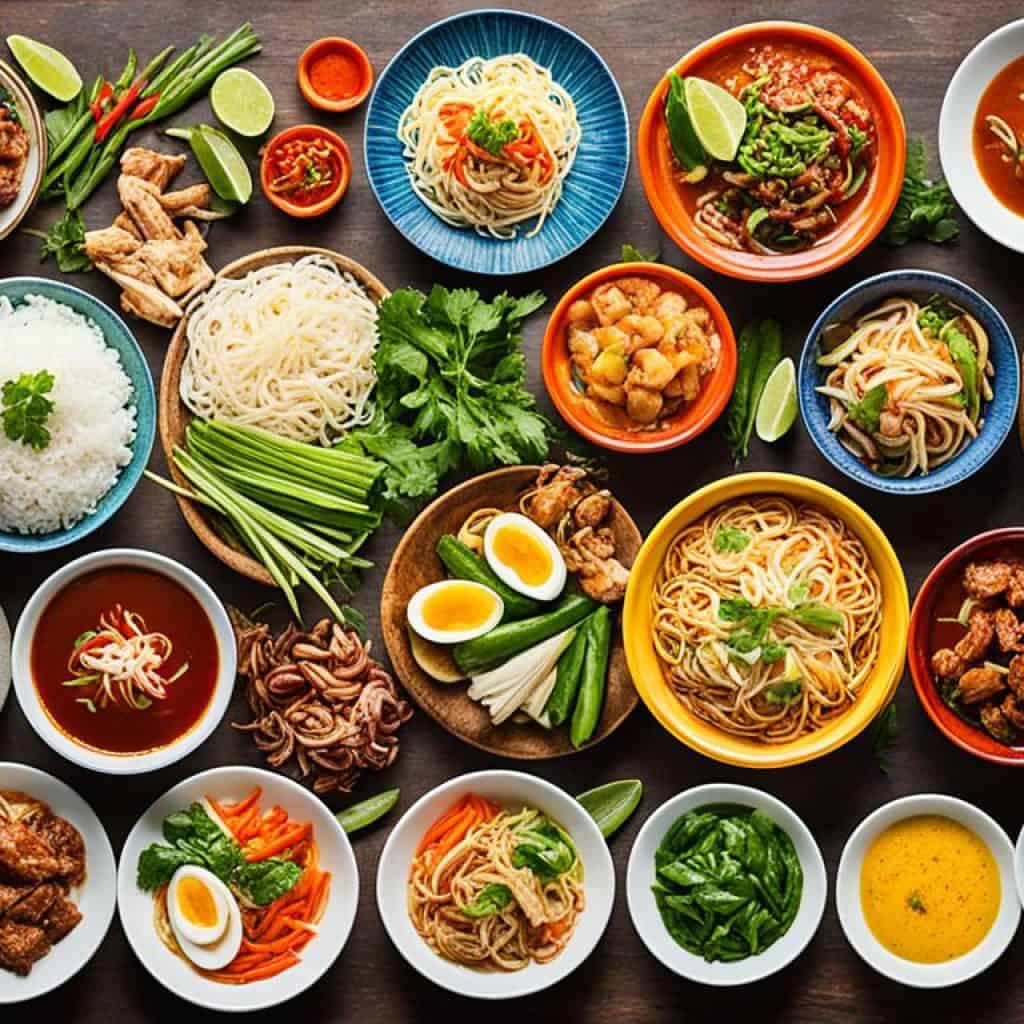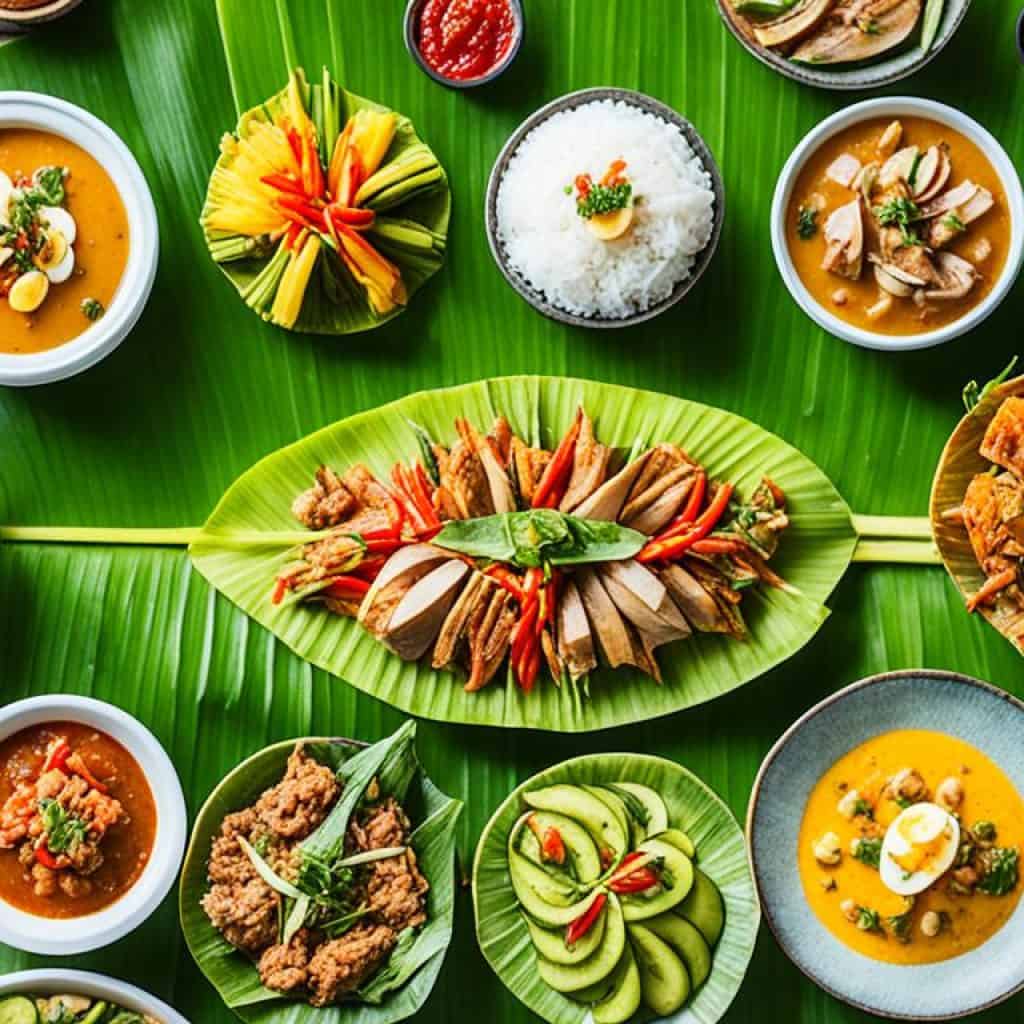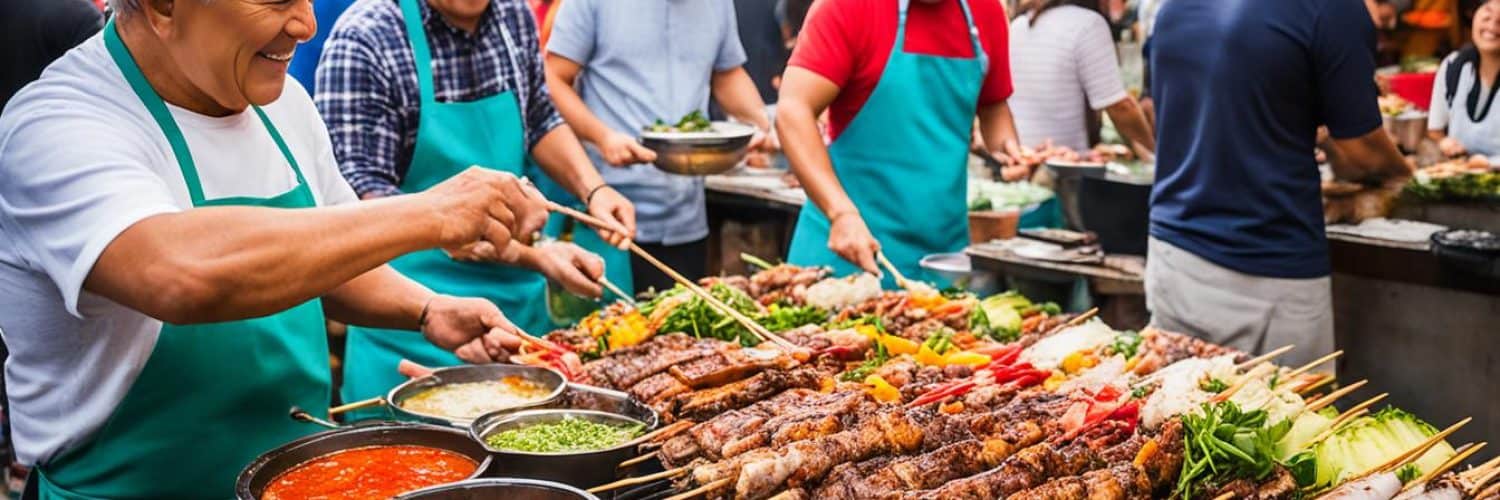Have you ever thought about why Filipino food is so tasty and unique? Or how the lively Filipino culture shows in its dishes? Let’s go on a journey to discover the deep traditions, heritage, and tastes of the Philippines.
Filipino food is becoming famous worldwide for its rich variety. It mixes different cultures, creating flavors that are sweet, sour, and salty all at once. This style of cooking makes Filipino dishes stand out. The culture of the Philippines is also full of traditions and a rich heritage. It has been shaped by its history and the influence of Spanish and American rule. From its colorful language to the Filipino community’s warm welcome, diving into Filipino culture and food is a joy.
Key Takeaways
- Filipino cuisine is known for its unique blend of sweet, sour, and salty flavors.
- Spanish and American colonialism have greatly influenced Filipino culture and cuisine.
- Filipino dishes like lumpia, pancit, and adobo are popular and represent the diverse flavors of the cuisine.
- Filipino dining culture emphasizes communal eating and a strong sense of connection.
- Regional variations in Filipino cuisine showcase the diverse flavors and traditions of each area.
The Evolution of Filipino Cuisine.
Filipino cuisine has evolved remarkably over time. It has been shaped by many cultures and historical events. Nowadays, the Philippines is a melting pot of various influences. Its food scene blends flavors from Spanish, Chinese, and American cultures beautifully. This mix has created a unique Filipino cuisine loved worldwide.
Spanish rule, lasting over 300 years, transformed Filipino cuisine significantly. It introduced new flavors, techniques, and ingredients. This blend of Latin and Filipino elements made the cuisine unique. Spices like paprika and saffron, along with tomatoes and onions, deeply impacted Filipino food.
The influence of American culture introduced fast food and processed foods into the Filipino diet. Dishes like burgers, hotdogs, and fried chicken became Filipino favorites. The American-Filipino fusion created comfort foods like sweet-style spaghetti and crispy fried chicken.
| Culinary Influences | Examples |
|---|---|
| Spanish Rule | Adobo, caldereta, menudo |
| American Influence | Fried chicken, burgers, hotdogs |
The blend of these influences has made Filipino cuisine diverse and flavorful. From traditional dishes such as adobo, sinigang, and lechon to modern fusion foods, Filipino flavors enchant everyone. Local and international food lovers enjoy these tastes.
“Filipino cuisine: a beautiful tapestry woven with the threads of Spanish rule and American influence, creating a flavorful and diverse culinary heritage.”
The Filipino Flavors
Filipino cuisine is known for its unique and captivating flavors. It combines sweet, sour, and savory tastes perfectly. The harmonious balance pleases every palate. Vinegar, soy sauce, and calamansi, a local citrus, add a refreshing tang to many dishes.
Filipino dishes cater to all cravings. From the hearty adobo to the tangy sinigang, the cuisine is robust. The Spanish and American influences enrich dishes with Filipino twists, such as tangy adobo and sweet-style spaghetti.
- Filipino cuisine embraces a delightful combination of sweet, sour, and savory tastes.
- Vinegar, soy sauce, and calamansi add tanginess and depth of flavor to Filipino dishes.
- From robust adobo to tangy sinigang, Filipino flavors never fail to impress.
The evolution of Filipino cuisine highlights its wide influences and ability to form a unique identity. It shows the vibrant history and cultural richness of the Filipino people.
Traditional Filipino Dishes.
Filipino cuisine is famous for its traditional dishes. These dishes showcase the rich flavors and ingredients unique to the Philippines. They are the heart of Filipino culinary heritage, loved for their unique taste.
The lumpia is a popular Filipino spring roll. It is crammed with minced meat and veggies. Once deep-fried, it becomes a crispy treat that balances taste and texture well.
Pancit is another favorite. It mixes noodles, meats, and veggies. Whether it’s pancit Canton or pancit Malabon, this noodle dish is a must-have in Filipino homes.
Chicken adobo is a standout in Filipino meals. Its meat is slow-cooked in soy sauce and vinegar, making it tender and tasty. Its unique flavor has won many hearts.
For dessert, leche flan is a top pick. This custard is creamy and topped with caramel. Every bite is a sweet delight.
Kare-kare is a savory stew known for its rich mix of flavors. Made with oxtail, vegetables, and peanut sauce, it’s a unique blend. The flavors of meat and peanuts create something special.
Sisig is for those who love bold tastes. Made traditionally from pig head and liver, it’s spicy and flavorful. This dish shows off Filipino creativity in cooking.
These dishes embody the rich flavors and creativity of Filipino food. Each bite invites you to explore the vibrant world of Filipino cuisine.
Try these classic Filipino dishes to taste the country’s rich food culture. Let these flavors take you to Manila’s streets or the peaceful Philippine towns. These dishes are proof of the Philippines’ colorful culinary history.
Explore more about the communal dining culture of Filipino food in the next section.
The Filipino Dining Culture.
In the Filipino dining world, food is more than just something to eat. It helps build strong social ties. Meals in the Philippines are often shared, creating a sense of belonging. Everyone gets to enjoy the food together.
A typical meal in the Philippines has a variety of dishes on the table. At its heart is steamed white rice. It stands in the center, symbolizing wealth and unity.
Small bowls of vinegar, fish sauce, and calamansi are also on the table. They let everyone spice up their meal as they like. This makes the dining experience personal and enjoyable.
“Kamayan” is a special way of eating in the Philippines. It means eating with your hands. During a kamayan feast, dishes are served on banana leaves. Everyone eats together, making the meal more interactive and fun.
Eating with your hands is known as “kinamot”. It’s not just practical; it shows the value of family, warmth, and being casual. This tradition highlights the Philippines’ rich food culture and love for communal meals.
Quotes:
“Filipino dining culture is about community and our love for great food. It’s for making memories and sharing joys over tasty dishes.” – Chef Antonia R.
Filipino Dining Culture Etiquette
| Dining Etiquette | Explanation |
|---|---|
| Passing Dishes | It’s polite to pass dishes to the right. This way, everyone can easily reach them. |
| Sharing Utensils | When eating in a group, sharing utensils is normal. Just remember to use the serving spoons or forks to put food on your plate. |
| Saying “Salamat Po” | Saying “Salamat po” or “Thank you” before and after eating shows respect. It’s a way to express thanks for the food and hospitality. |
| Leaving No Leftovers | Finishing your meal is a sign of respect for the host. It shows you appreciate the time and effort they put into it. |
The Filipino dining culture beautifully shows the country’s strong community and love for tasty food. From simple home meals to big kamayan feasts, these experiences bring joy, closeness, and lots of delicious food.
Filipino Cuisine’s Culinary Influences.
Filipino food brings together many culinary styles. This mix makes the cuisine rich and flavorful. Through history, different cultures added their touch to Filipino dishes. This resulted in a unique blend of tastes. For example, Chinese traditions were introduced by traders. They brought techniques and ingredients that are now key to Filipino cooking.
Spanish colonizers also left a big impact. They ruled the Philippines for 300 years. They brought tomatoes, garlic, and olive oil. They also introduced frying and braising. Dishes like adobo and paella have Spanish roots but are Filipino favorites now.
But it’s not just about foreign influences. Indigenous tribes of the Philippines have greatly contributed too. They used local crops and spices. This added depth to Filipino food. The use of taro, cassava, and native herbs is widespread.
“The blend of culinary influences from Chinese, Spanish, and indigenous cultures has created a diverse and flavorful cuisine. This cuisine showcases the Philippines’ rich cultural heritage.” – Filipino Food Expert
Filipino cuisine is truly vibrant and varied. It combines Chinese, Spanish, and indigenous techniques. This blend offers a wide range of flavors. There’s something familiar yet exotic, inviting everyone to explore.
Culinary Influences on Filipino Cuisine
| Culinary Influence | Examples |
|---|---|
| Chinese | Lumpia (spring rolls), Pancit (noodles) |
| Spanish | Adobo, Paella |
| Indigenous | Suman (sticky rice), Kinilaw (ceviche) |
The mix of culinary influences makes Filipino cuisine deeply flavorful. It reflects the Philippines’ history, culture, and heritage. Exploring this cuisine lets you taste the legacy of different cultures. It offers a genuine insight into Filipino food culture.

Unique Flavors of Filipino Cuisine.
Filipino cuisine stands out for its unique flavors. It mixes sweet, sour, and salty tastes. This mix comes from ingredients like vinegar, soy sauce, and calamansi.
This combination gives a balance that is tasty and fulfilling.
From the tangy adobo to the rich kare-kare, and the spicy sisig, Filipino dishes excite the taste buds.
Explore the wonderful flavors of Filipino cooking. It combines sweet, sour, and salty tastes in a unique way. Try the tangy adobo, rich kare-kare, or spicy sisig.
Filipino recipes use special flavors like vinegar, soy sauce, and calamansi. This creates a perfect balance of taste. Discover the variety that makes Filipino cuisine amazing.
Popular Filipino Dishes.
Filipino cuisine is loved not just in the Philippines, but around the world. It brings unique flavors and traditions to the table. Here are some top Filipino dishes to explore:
Lumpia
Lumpia is a favorite among many. These are deep-fried spring rolls with meat and veggies inside. They’re perfect as a snack or appetizer.
Pancit
Pancit is a versatile noodle dish with ingredients like meat, veggies, and seafood. It comes in different varieties like pancit canton, bihon, or malabon. Each one offers a unique and satisfying flavor.
Adobo
Adobo is a classic Filipino dish, slow-cooked with meat in vinegar, soy sauce, garlic, and spices. It’s a savory dish with a distinct tangy taste. A must-try for food enthusiasts.
Sinigang
Sinigang, a sour soup, is a favorite comfort food in the Philippines. It includes meat or seafood and veggies in a tamarind broth. Its unique tangy and savory taste makes it perfect for rainy days.
Lechon
Lechon, a whole roasted pig, is essential at any Filipino party. Its crispy skin and tender meat are simply delicious. Slow-roasting gives it a smoky flavor, making it the highlight of festivities.
Filipino cuisine offers a variety of delightful dishes. From crispy lumpia to savory adobo, each dish showcases Filipino culture and tradition. So, get ready for a wonderful culinary journey with these popular dishes.
Regional Filipino Cuisine.
Filipino cuisine is rich with different flavors and dishes. It varies across the Philippines. Each region has its unique dishes, ingredients, and ways of cooking. This showcases the variety of Filipino food.
Luzon
Luzon is the largest group of islands in the Philippines. It offers a range of popular dishes. Adobo is a key dish, made with meat marinated in vinegar, soy sauce, garlic, and spices.
Pancit, a stir-fried noodle dish with meats and veggies, is another main dish from Luzon.
Visayas
The Visayas region is famous for its tasty and celebratory dishes. Lechon, a whole roasted pig, is a major dish at parties. Its crispy skin and juicy meat are loved by many.
Another favored dish is Batchoy. It’s a noodle soup with pork offal, topped with crispy garlic. It comes from the Visayas.
Mindanao
Mindanao, located in the south, has its unique dishes. Inihaw na panga, or grilled tuna jaw, is a local specialty. It’s marinated with spices.
Piyanggang manok, a grilled chicken marinated in tangy spices, is also popular. It’s known for its smoky flavor.
Exploring Filipino cuisine from Luzon, Visayas, and Mindanao is like a food tour. You discover unique tastes and dishes special to each region. It shows the distinct culinary traditions of the Philippines.
The Origins of Filipino Cuisine and Food Culture.
Filipino cuisine’s rich heritage comes from a mix of many cultures and histories. It weaves together local traditions and foreign touches. This blend creates the unique tastes and cooking methods we see today.
At its heart, Filipino food uses local ingredients and age-old cooking ways. The wide variety of fresh produce, tropical fruits, and seafood makes Filipino dishes vibrant and flavorful.
Over time, the Philippines met many cultures. Chinese traders introduced noodle dishes and steamed buns. For over 300 years, Spanish colonizers added their own ingredients and cooking styles. They brought tomatoes, onions, and garlic, along with adobo and sofrito methods.
“Filipino cuisine is a delightful blend of traditions, techniques, and ingredients that have been passed down through generations.”
Then came American influences, introducing corned beef, canned goods, and a taste for fast food. Japanese occupation inspired Filipino takes on tempura and kare-kare.
The Philippines is also influenced by its location in Southeast Asia. Spices, herbs, and tropical fruits are common. This reflects the shared tastes of the region.
All these outside influences have mixed with local cooking ways. This mix has created a unique Filipino cuisine, showing the country’s rich history and diverse cultures.

Regional Variations in Filipino Cuisine
Local variations add further diversity to Filipino cuisine. Each part of the country has its own dishes and cooking styles.
| Region | Specialty Dishes |
|---|---|
| Luzon | Adobo, sinigang, sisig |
| Visayas | Lechon, batchoy |
| Mindanao | Inihaw na panga, sinuglaw |
Exploring the Philippines lets you discover local flavors and traditions. From Luzon’s adobo to Visayas’ lechon, and Mindanao’s spicy dishes, every region has something special.
Embracing Filipino cuisine means exploring its roots and the cultural influences that shaped it. Enjoying a traditional meal or trying street food, Filipino cuisine offers a journey for the senses.
Exploring Philippine Regional Cuisine.
Philippine regional cuisine is rich with unique, tasty local dishes. These dishes showcase the diversity of the Philippines’ culinary heritage. Every region offers distinct flavors, ingredients, and cooking methods. From Luzon’s north, to Visayas’ islands, and down to Mindanao, the flavors captivate food lovers.
Luzon Food: Adobo, Sinigang, and Sisig
Luzon is the Philippines’ largest island group, known for its northern flavors. Adobo, a famous dish, is savory and tangy, made with meat, vinegar, soy sauce, and spices. Sinigang, a sour soup, features tamarind with various meats and vegetables. Then there’s sisig. It’s a bold dish made from pig’s head and liver, flavored with calamansi and chili peppers.
Visayas Food: Lechon and Batchoy
The central islands of Visayas offer mouthwatering dishes. Lechon, a whole roasted pig, stars in Filipino festivities. Its crispy skin and tender meat delight crowds. Visayas is also known for batchoy. This noodle soup is rich, containing pork offal and chicharon, topped with a raw egg. Lechon and batchoy showcase Visayas’ rich culinary heritage.
Mindanao Food: Inihaw na Panga and Sinuglaw
Discover the unique flavors of Mindanao’s south. Inihaw na panga, or grilled tuna jaw, is a highlight. It’s marinated and grilled, offering tender, smoky flavors. Sinuglaw combines grilled pork and ceviche for a tangy, fresh taste. This dish demonstrates Mindanao’s creative cuisine fusion.
Exploring the Philippines’ regional cuisines opens up a world of unique tastes and traditions. From Luzon’s savory adobo to Visayas’ lechon and Mindanao’s bold dishes, each region reflects local culture. For food lovers or the curious, a culinary tour of the Philippines offers rewarding, unforgettable experiences.
| Region | Featured Dishes |
|---|---|
| Luzon | Adobo, Sinigang, Sisig |
| Visayas | Lechon, Batchoy |
| Mindanao | Inihaw na Panga, Sinuglaw |
Traditional Filipino Food Experiences.
Immerse yourself in traditional Filipino food to truly grasp its richness. Through Filipino food tours and culinary tourism, you get a unique chance. These experiences let you taste authentic dishes, learn traditional cooking techniques, and talk with local chefs and food experts.
Start your culinary journey by exploring vibrant food markets. These markets burst with the colors and smells of fresh produce, spices, and ingredients. Meet local vendors at these markets. They will share their knowledge and tales about traditional Filipino ingredients. This adds depth to your food exploration.
Further dive into Filipino cuisine by taking part in traditional cooking classes. Skilled chefs will teach you how to make classic Filipino dishes. You’ll learn about flavor combinations and cooking methods unique to Filipino cuisine. Try making dishes like adobo, sinigang, or pancit. It’s joyful to learn traditional Filipino recipes.
These culinary adventures offer more than just food. You gain insights into the culture and history behind Filipino cuisine. Filipino food tours and culinary tourism create an immersive experience. They fill your senses with the Philippines’ sights, sounds, and flavors.
For anyone interested in Filipino cuisine, these tours are an amazing opportunity. You’ll connect with local communities, hear their stories, and dive into their culture. And you do this through one of the most loved parts of their culture – their food.
Experience the authentic flavors of the Philippines and make unforgettable memories. Explore the unique flavors, textures, and aromas of Filipino cuisine on this journey.
Embracing Authentic Filipino Cuisine.
Exploring authentic Filipino cuisine is more than enjoying tasty meals. It’s about understanding the rich history and cultural influences behind Filipino food culture. This appreciation connects you deeper to the nation and its people.
By trying traditional Filipino dishes, you expand your culinary knowledge. You also grow to love the complexity of Filipino food. Diving into the vibrant world of Filipino cuisine lets you enjoy a unique mix of flavors.
The Melting Pot of Filipino Flavors
Filipino cuisine comes from a rich mix of cultures and cooking styles. For centuries, influences from Spanish, Chinese, American, and native cultures have blended. This mix has created a unique and diverse food culture in the Philippines.
“Filipino cuisine is like a harmonious symphony, with each ingredient playing a vital role in creating a memorable culinary experience.”
You can enjoy a range of flavors in Filipino dishes, from tangy adobo to savory sinigang. Don’t forget regional dishes like Bicol Express and pinakbet. They offer special tastes to discover.
The Joy of Sharing Filipino Food
In Filipino culture, sharing food is more than eating. It’s a way to connect with others. Sharing a meal, be it simple or festive, is key to Filipino dining traditions.
“Boodle fights” or “kamayan” are unique dining experiences. Food is eaten off banana leaves with hands. This style brings people together, making meals memorable.
A Culinary Journey through the Philippines
Traveling through the Philippines offers a deep dive into its food culture. From markets to local eateries, each place has something special.
- Experience Manila’s street food, with grilled skewers, crispy pork sisig, and halo-halo.
- Visit Cebu for fresh seafood like grilled squid, crispy pata, and kinilaw.
- Explore Pampanga, the culinary capital, and try dishes like sisig, bringhe, and morcon.
An Appreciation for Filipino Culinary Heritage
To really appreciate Filipino cuisine, understanding its heritage is key. Every dish has a story, showing the history and tastes of Filipino people. By valuing Filipino food culture, we help keep this vibrant culinary heritage alive.
So, enter the world of Filipino cuisine, experience its rich flavors, and start a culinary journey. It will not just delight your taste buds but also grow your love for Filipino food’s beauty and diversity.
Conclusion.
Exploring Filipino culture and cuisine opens a world of flavors and traditions. It shows the diverse culinary influences and the warm hospitality. This offers a unique experience for those who love food and travel. By diving into Filipino cuisine, you discover tasty dishes. You also understand the rich culture and heritage of the Filipino people.
Tasting the savory flavors of chicken adobo is a delight. So is indulging in the crispy goodness of lumpia. Filipino cuisine is a celebration. It shows the country’s diverse culinary influences and traditions.
Embark on a journey to discover the authentic flavors of the Philippines. Create unforgettable culinary memories. From food markets to family dining, discovering Filipino flavors will give you a new appreciation. It will show you the vibrant Filipino culture and cuisine.







Add comment